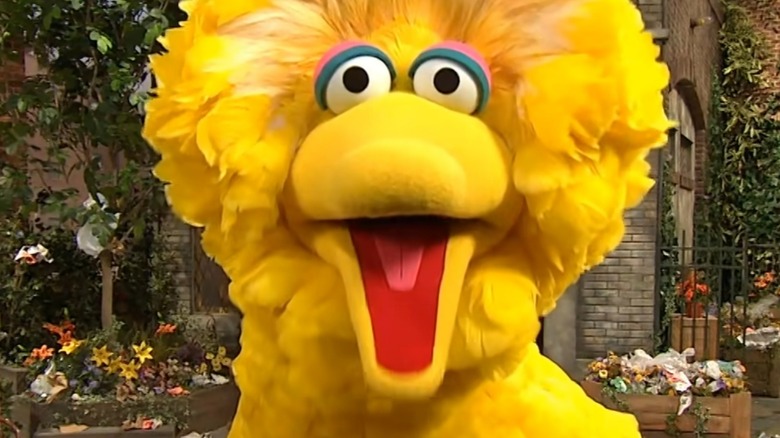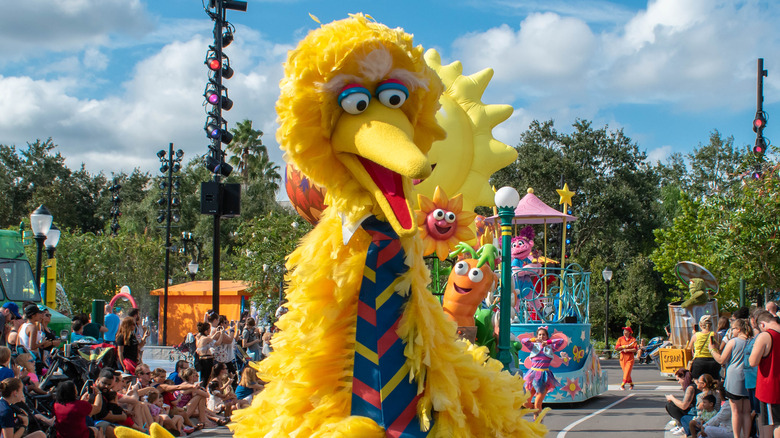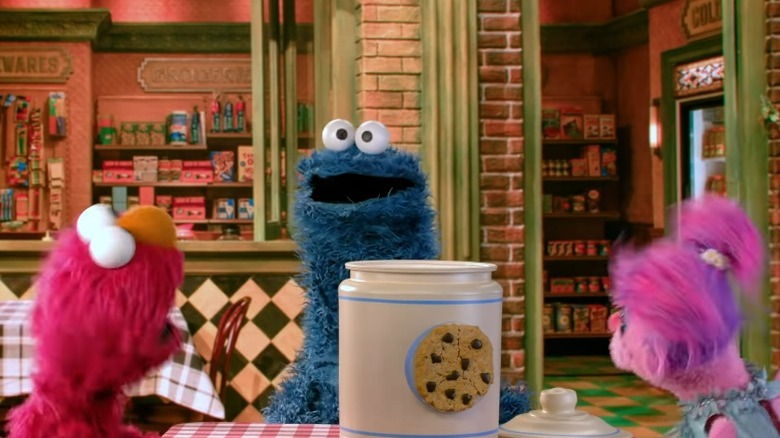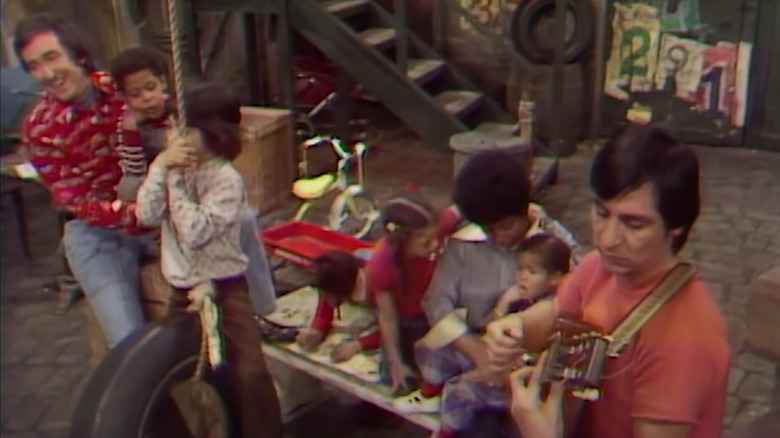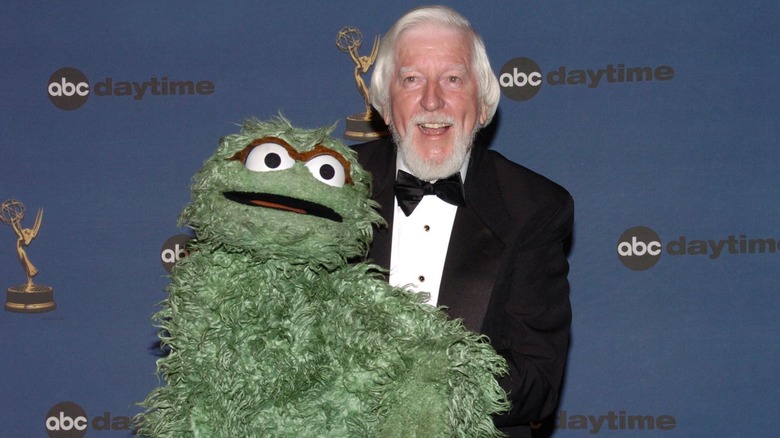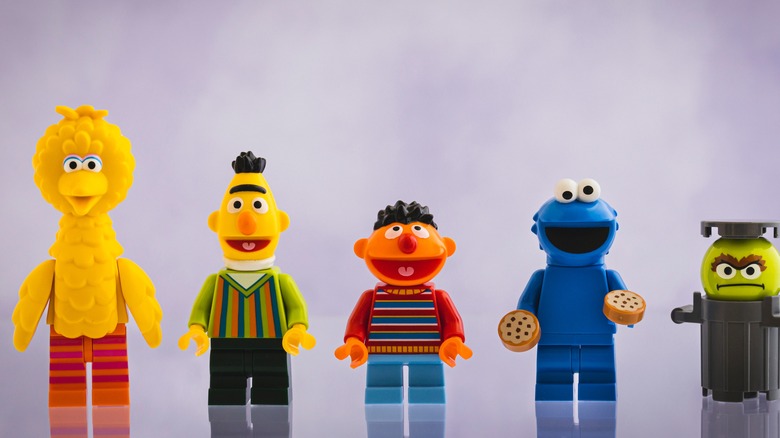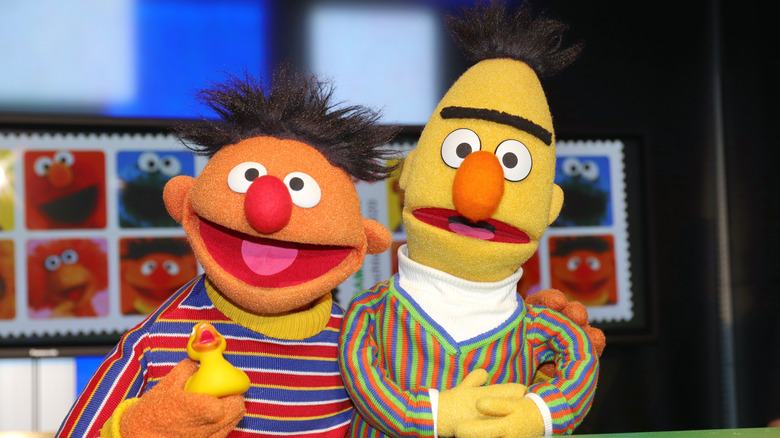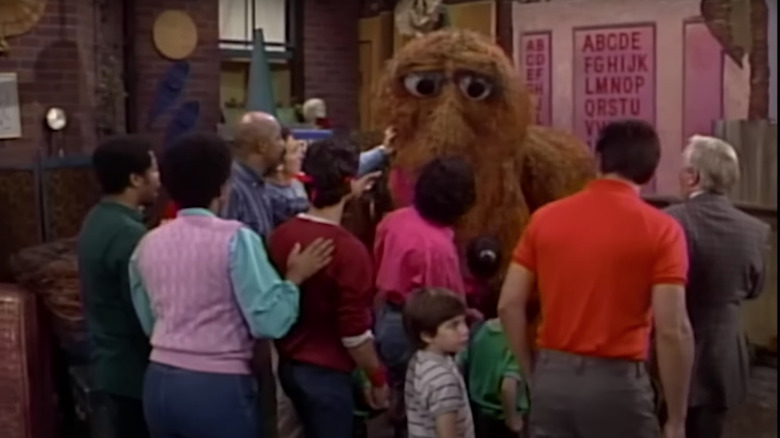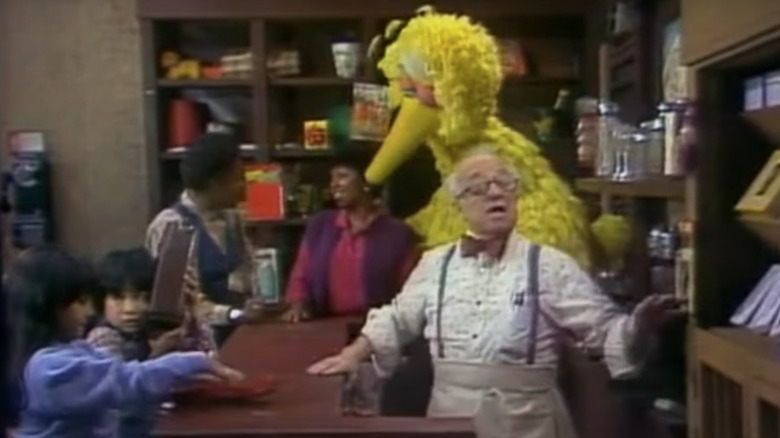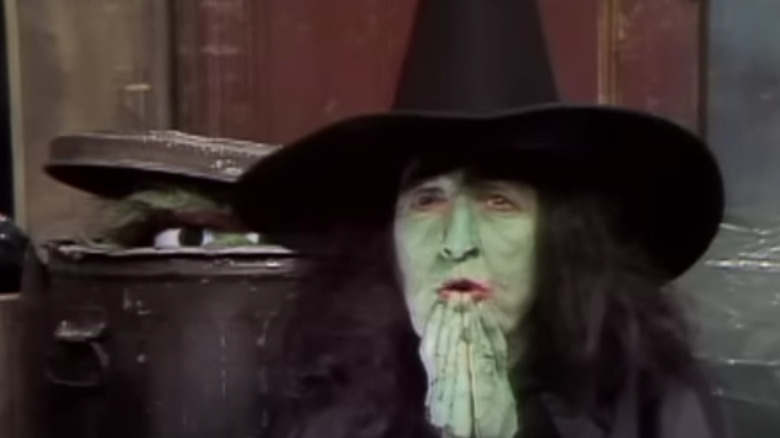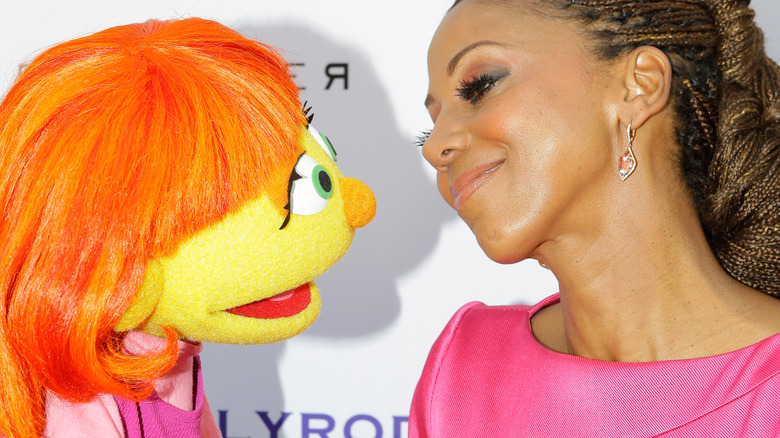Sunny Sesame Street Facts Only Big Fans Know About The PBS Staple
For so many of us, "Sesame Street" was a big part of growing up. Multiple generations of children have come to love the legendary characters, like Big Bird, Bert and Ernie, Oscar the Grouch, and Elmo, to name a few. Kids and parents also love the classic songs, like "Rubber Ducky" and "C is For Cookie," and the friendly neighbors like Bob, Susan, Gordon, Luis, Maria, Mr. Hooper, and more.
"Sesame Street" is the longest-running children's show in U.S. history. It's been on the air since November 10, 1969, and it has been shown in over 150 countries around the world. The show has lasted because of the caliber of talent involved — such as visionary puppeteer Jim Henson — and because it also taught great lessons in a wonderful way that never talked down to kids. As "Sesame Street" composer Joe Raposo once told South Coast Today, "Children are not stupid people –- they're just little people."
Still, even if you watched "Sesame Street" every day as a child and kept the tradition going with your own children, there's still plenty about the show you may not already know. Here are some "Sesame Street" facts that only big fans would know about the show.
The origins of Sesame Street
"Sesame Street" was created by Joan Ganz Cooney, who is also a co-founder of the Children's Television Workshop. Cooney was formerly a journalist, and in 1966 she worked on a study called "The Potential Uses of Television in Preschool Education." One of the reasons the study was conducted was because it was believed television could be a great tool to teach children from disadvantaged families. As Cooney explained in "Street Gang: How We Got to Sesame Street" about the show's development, "To me it was clear the kids just adored the medium, so why not see if it could educate them?"
This was important for disadvantaged families whose children would be home watching the show, as it could help them keep up with other kids their age who may have more access to educational resources. As psychologist Lloyd Morrisett — another co-founder of the Children's Television Workshop – explained, "We found that those children would enter school three months behind, and by the end of first grade, be a year behind –- and get further and further behind. And I wondered whether there was a possibility that television could be used to help children with school" (via The New York Post).
Jon Stone, an executive producer for "Sesame Street," also wanted the show to be in a more realistic environment than the usual kids' shows of the time. As Stone said, "I wanted to do 'Sesame Street' as it appears today, which is an inner-city street in a kind of a run-down neighborhood with garbage cans on the street" (via The Washington Post).
The Jim Henson origin story
Although Cooney built the "Sesame Street" foundation and producer Jon Stone was a major driving force behind the show, "Sesame Street" has often been identified with the late Jim Henson, who revolutionized puppetry and created his own wonderful species, the Muppets.
With his long brown hair and thick beard, Henson was often called a hippie, and he was a gentle soul whose quiet and loving nature helped him to create this landmark educational television series for children. Growing up in Mississippi, Henson loved puppetry, and he was a big fan of the televised puppet show "Kukla, Fran and Ollie." Henson first broke into local television with the show "Sam and Friends," the first show to feature the Muppets, and he won a local Emmy when he was in his early twenties. Prior to "Sesame Street," Henson's creatures were featured on "The Ed Sullivan Show" and "The Jimmy Dean Show" while also directing commercials for Wilkins Coffee.
Producer Jon Stone recommended Henson for "Sesame Street," who brought Cookie Monster performer Frank Oz with him (via The New York Post). Getting Henson was a major coup for the show and the perfect vehicle for Henson to bring his wonderful creations to a larger stage.
Where the best known characters came from
The late Jon Stone, one of the creators and driving forces of "Sesame Street," helped create some of the most legendary characters for the show, such as Big Bird and Oscar the Grouch. As the Tampa Bay Times reports, Stone wrote the pilot for "Sesame Street" and became the show's executive producer. Stone was originally a producer for "Captain Kangaroo," and Joan Cooney convinced him to come over to "Sesame Street."
At first, Big Bird was supposed to be something of a southern hick character, but puppeteer Caroll Spinney saw Big Bird as a six-year-old kid, which made him a younger character than his fellow Muppets. As Sonia Manzano, who plays Maria, said, "I have always loved Big Bird because he's complicated. He has a lot of emotional qualities that the other Muppets don't have" (via Roger Ebert). As for Oscar the Grouch, Independent reports that Spinney borrowed the voice from a cab driver and joked, "Who could be more of a grouch than a cabdriver from the Bronx?"
As for Cookie Monster, an early version of the magical creature with blue fur was appearing in commercials as early as 1966 (via Biscuit People). When Henson first created him, he was known as the "Wheel-Stealer," where he had sharper teeth and ate wheel-shaped snacks.
The musical genius of Sesame Street
You may not know the name Joe Raposo, but you certainly know his music. He's the composer of "It's Not Easy Bein' Green" and "C is For Cookie," to name just a few. Raposo also cowrote the well-known "Sesame Street" theme with Jon Stone and Bruce Hart.
Raposo was a prolific and versatile composer who wrote thousands of pieces of music for "Sesame Street," according to South Coast Today. However, it wasn't just kids that loved his music. Many great artists covered his work, including Frank Sinatra, who South Coast Today reports called Raposo was "a genius," Ray Charles, The Carpenters, and more. Raposo also worked quickly and wrote "It's Not Easy Bein' Green" overnight.
Raposo wrote great music for children and for the child in all of us. As Jim Henson explained, "I think Joe was very much in touch with the child within himself and could express it and could see the world through that child and could write songs about it." Raposo died young at the age of 51, but he left a wonderful legacy of music behind him. As Carroll Spinney put it, "You knew it was gonna be great if he wrote it."
The man behind Big Bird and Oscar the Grouch
A lot of people aren't aware of the fact that Big Bird and Oscar the Grouch were played by the same person, Caroll Spinney. As Henson recalled (via NPR), he first met Spinney in August 1969. "He's a very talented performer and he had a great sense of ad-libbing. And he was doing this strange-looking cat on local television in Boston. And so we started talking ... and I asked Caroll if he'd enjoy coming and being part of this very strange bird."
Some have a hard time believing Spinney could play characters as dissimilar as Big Bird and Oscar, but both characters reflected his personality. "I loved playing Oscar," Spinney recalled. "He has a power I never had ... I can't believe that Jim gave me two such characters that have become iconic, and are a part of so many people in America growing up." Spinney also saw Big Bird as "a child, a surrogate. He can be all the things that children are. He can learn with the kids."
Spinney died in 2019 of complications of a muscle disorder called dystonia at the age of 85.
Jim Henson had to be convinced to do merchadise
Doing merchandise for a children's show seems like a no-brainer. It gives kids wonderful toys they can cherish growing up, and it creates an income stream that can rake in millions. However, it took Jim Henson some convincing to pursue merchandising for "Sesame Street."
When Henson signed up with the Children's Television Workshop, he wanted to keep the rights to his characters (via The New Yorker). Being an idealistic hippie, he didn't want to sell them out for a quick buck. Bernie Brillstein, who was Henson's manager, was finally able to convince Henson to do it. As Brillstein recalled in his memoir, "Where Did I Go Right?" he told Henson, "Every child in America is watching this show, and one day it will be worldwide. Shouldn't they have good dolls instead of the s*** they're buying now? Shouldn't they have Kermit and Bert and Ernie? You can't not give it to them."
Brillstein promised Henson he'd have approval, "full control," of everything that's being done. "You'll approve every license," Brillstein explained. With the money rolling in from merchandise, it would give Henson the artistic freedom he needed. Henson was finally sold, even if it took a bit of convincing.
The Bert and Ernie controversy
In the mid-'90s, people started humorously looking for alleged gay subtext in a number of movies, like Quentin Tarantino's character famously does for "Top Gun" in "Sleep With Me." Around that time, an urban legend started circulating that Bert and Ernie were more than close friends. Maybe it started as a joke, but for a long time now, many have wondered if they are indeed gay.
The debate still rages to this day. A 2018 report on Reuters explained that Bert and Ernie weren't gay — or straight, for that matter. According to the Sesame Workshop, they were best friends, and as the organization tried to explain on Twitter, Muppets "do not have a sexual orientation. They were created to teach preschoolers that people can be good friends with those who are very different from themselves."
Yet Mark Saltzman, a writer for "Sesame Street," told the blog Queerty that Bert and Ernie were gay as far as he was concerned, and he drew from his own relationship with his life partner for inspiration. "I always felt that without a huge agenda, when I was writing Bert and Ernie, they were. I didn't have any other way to contextualize them. The other thing was, more than one person referred to Arnie and I as 'Bert and Ernie.'"
Was Snuffleupagus real or an imaginary friend?
Many of us had imaginary friends growing up, but with Snuffleupagus, or Snuffy, as Big Bird called him, it wasn't clear for decades whether he was real or make-believe.
Snuffy first appeared on the show in 1971, and no one else saw the giant, shambling creature except Big Bird. Emilio Delgado, who played Luis, said, "It was going with the whole thing of a child's imaginary playmate, which a lot of kids have" (via Smithsonian). However, Martin P. Robinson, who actually played Snuffy, begs to differ. "He was shy," Robinson said. "He had bad timing, and the joke was, he's big, you can't miss him, but adults being the way they are -– preoccupied, going to work -– they miss those little details. And Snuffleupagus just happened to be one of those little details that they kept missing year after year after year."
Finally, after 17 seasons, it was revealed that Snuffy was indeed a real creature on "Sesame Street" — but it was a fun guessing game for many years regardless.
How Sesame Street dealt with Mr. Hooper's death
Death is hard for young children to deal with. When the actor who played Mr. Hooper, Will Lee, died in real life, the producers of "Sesame Street" decided they would deal with it on the show. Not only would the episode teach children how to cope with death, but it was also one of the most memorable episodes in the show's history that affected many of us, young and old.
Being childlike in nature, Big Bird has a hard time wrapping his head around the fact that Mr. Hooper died, but everyone tries to cope and grieve together while helping him understand that he would always live on in their memories. Spinney recalled crying underneath his Big Bird costume during the scene, and he later said, "I think it was one of the best things we ever did" (via The A.V. Club). Sonia Manzano, who played Maria, recalled that it was "one of the high points of the show's career and one of the times I felt most proud to be associated [with 'Sesame Street']" (via Archive of American Television). She further explained that show producer Dulcy Singer felt, "Why shortchange the kids now? Death is part of life ... Why should we not illustrate it and explain it?"
The episode was critically acclaimed. As The A.V. Club wrote, "Mr. Hooper's death was revolutionary because of its frank discussion of a complicated subject that does not fit squarely into the box of children's entertainment."
The lost episode that scared children
"The Wizard of Oz" is a beloved family classic, but it had characters that were terrifying to children, like the Wicked Witch of the West, played by Margaret Hamilton. As it turns out, the Witch was still scary to kids when she appeared on "Sesame Street" in 1976, and after a number of complaints from parents, a "Sesame Street" episode featuring her was too dar for PBS made it to air.
The episode was rediscovered last year, and it was apparently leaked to YouTube by an anonymous fan. Thankfully the show wasn't totally lost because, as SlashFilm explains, the footage was thankfully stored in the Library of Congress.
Ironically enough, Hamilton appeared on "Mister Rogers' Neighborhood" the previous year, but she was on the show without makeup, showing kids that underneath it all, she was a kind person. Mr. Rogers himself even said, "Not all witches have to be bad."
The HIV positive and autistic Muppets that broke new ground
"Sesame Street" always taught important lessons about accepting people that are different. The show has long used new characters to introduce children to issues they may not be familiar with, and in recent years they created a Muppet with autism, Julia, and a Muppet that was HIV positive, Kami.
Kami was created for the South African version of "Sesame Street" in 2002, and her character was created to help reduce the stigma against HIV and AIDS (via One). In South Africa, HIV and AIDS affect thousands of children, and the character, who is supposed to be five years old, contracted the disease from a blood transfusion. Time points out that Kami means acceptance in Setswana.
With Julia, who has autism, the Sesame Workshop began working on the character in 2010, and she finally made her debut in a children's book, "We're Amazing, 1,2,3." She made her live-action debut on the show in 2015, and as Rose Jochum of the Autism Society of America said, "My reaction was total excitement, the excitement of seeing a new life come into the world. For all the little kids who have autism, it's validating to see characters like themselves on television, instead of feeling invisible" (via Smithsonian).
Members of the cast you may not know passed away
Recently, "Sesame Street" suffered two terrible losses when Emilio Delgado, who played Luis, and Bob McGrath, who played Bob, passed away.
Delgado was a 45-year veteran of the show, and he was one of the few Latin performers people you could see regularly on TV back in the early seventies — just like Maria, who was played by Sonia Manzano. As Delgado recalled, "There really wasn't any representation of actual people. Most of the roles that I went out for were either for bandits or gang members" (via PBS). When producer Jon Stone reached out to Delgado about a role on the show, "He didn't want actors. He wanted real people."
As one entertainment reporter remarked on Twitter, "Luis and Maria were the first Latinos I ever saw on TV. They were a huge part of my family. They paved the way."
Bob McGrath was with "Sesame Street" since the pilot episode, and stayed with the show for 45 seasons. Like Luis, he was a warm and welcoming presence on the show, with a large, beaming smile, and an incredible singing voice. One of his best-known songs was "People in Your Neighborhood."
Delgado died on March 10, 2022 at the age of 81, and McGrath died on December 4, 2022 at the age of 90.
